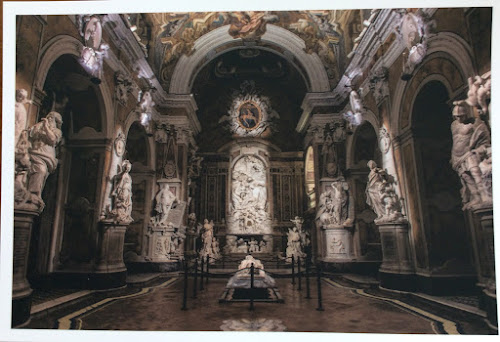We also visited the incredible Cappella Sansevero, one of the most impressive places on the trip in my opinion. All of the descriptions below are from Rick Steves' Italy guidebook. And all of the pictures are from postcards (and mostly in black & white) because photography was not allowed. Here is a link to a YouTube video which will give you a much better idea of what it looks like: https://m.youtube.com/watch?v=KHd18bwJVgM
Cappella Sansevero is the personal chapel of Raimondo de Sangro, an eccentric Freemason, containing his tomb and the tombs of his family. Like other 18th-century Enlightenment figures, Raimondo was a wealthy man of letters, scientist and inventor, and patron of the arts—and he was also a grand master of the Freemasons of the Kingdom of Naples. His chapel—filled with Masonic symbolism—is a complex ensemble, with statues representing virtues such as self-control, religious zeal, and the Masonic philosophy of freedom through enlightenment.
In the center of the chapel is the amazing Veiled Christ statue which is carved out of marble (by Giuseppe Sammartino, 1753) and shows the body under an incredibly realistic veil. The Christian message (Jesus died for our salvation) is accompanied by a Masonic message (the veil represents how the body and ego are obstacles to real spiritual freedom). [The pillows and matress are also marble. - JT]
Raimondo’s mom and dad are buried on either side of the main altar. To the right of the altar, marking his father’s tomb, a statue representing Despair or Disillusion struggles with a marble rope net (carved out of a single piece of stone), symbolic of a troubled mind. The flames on the head of the winged boy represent human intellect—more Masonic symbolism, showing how knowledge frees the human mind.
To the left of the main altar is a statue of Modesty, marking the tomb of Raimondo’s mother (who died after his birth, and was only 20). The veiled woman fingers a broken tablet, symbolizing an interrupted life.
Among his inventions was the deep-green pigment used on the ceiling fresco. The inlaid M. C. Escher-esque maze on the floor around de Sangro’s tomb is another Masonic reminder of how the quest for knowledge gets you out of the maze of life. This tilework once covered the floor of the entire chapel.





No comments:
Post a Comment